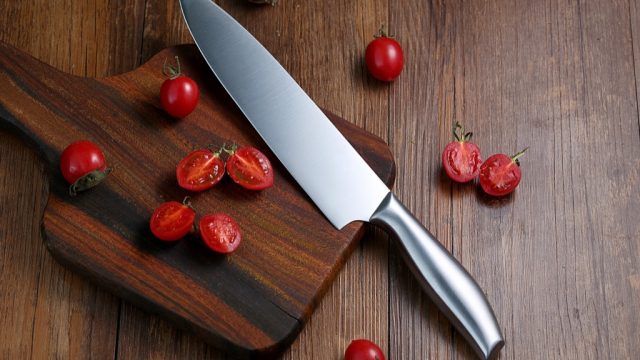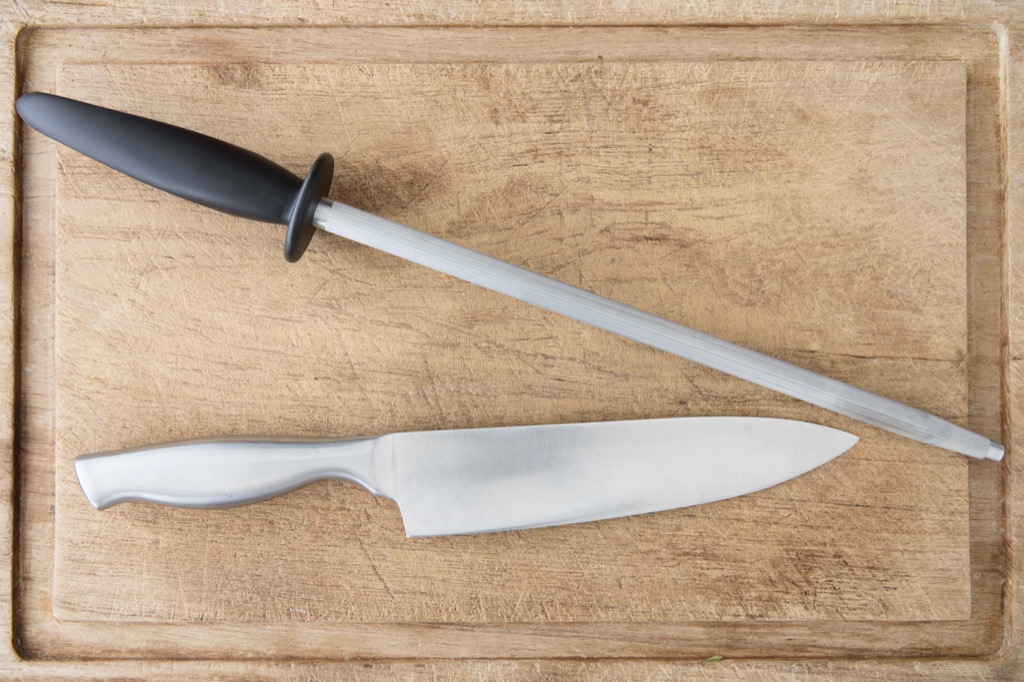This is the Safest Way to Sharpen a Knife
Keep your fingers intact with this tip for safely sharpening your knives.

So, you've blossomed into culinary adulthood and have finally purchased the kind of knives that deserve regular sharpening. Now, you just need to figure out how to do that without losing a finger.
If you've invested any significant cash in your new blades, knife-sharpening is likely available at your place of purchase. However, if you'd rather DIY it, there are some things to keep in mind to ensure you do it safely.
First, before you delve into the sharpening process itself, practice good maintenance. This means using proper knife storage, like a magnetic strip or wooden block, rather than letting your knives clang around in an unruly knife drawer. Having your knives bump against each other in a drawer can dull their blades more easily, making them less safe and more maintenance-intensive.

Before you use your knife, first give it a few swipes against a honing steel to make sure the edge is "true", or straightly aligned instead of curved subtly toward the center. This is important because a near-invisible curve in a blade can trick novice chefs into thinking their knife is dull and sharpening too often. If you have time, give your knife a pass across the honing steel each time before you cook.
Now, to get down to the serious business of actually sharpening your knives.
With proper maintenance, sharpening your knives should only be necessary two to three times per year. If you sharpen your knife too frequently, you may actually whittle down the metal, reducing the lifespan of your blade. The three most common options to choose from are a mechanical sharpener, a manual sharpener and a whetstone. The whetstone is the most respected within the culinary world for its precision. It's also the method that most requires an accompanying safety lecture.

If you choose to go the whetstone route, you'll need the right tools, including a stone with the appropriate amount of grit on each side. Whetstones typically include a coarse side for the actual sharpening of the blade, and a finer side for polishing. Any culinary store can help direct you to the appropriate type of whetstone for the blade you're hoping to sharpen. Check the stone manufacturer's specifications to determine how long to soak it prior to use and be sure to use water to clean it. Using oil-based whetstone cleaners can make tiny pieces of shaved-off steel stick to both the stone and your blade, dulling it over time.
Next, place a rubber mat underneath your stone to ensure it doesn't slide while you use it. Using your dominant hand to grip the handle, hold the knife horizontally over the stone at a 15- to 20-degree angle. Place your other hand evenly across the top side of the blade, gently applying even pressure as you run the edge of the knife across the whetstone. Do anywhere between six and 25 strokes on each side, alternating sides more frequently as you get closer to your desired sharpness.
When you finish, be sure to revisit that honing steel for a few strokes to finish off the job. Most importantly, remember this: the key to keeping yourself safe is using smooth, slow, even strokes, and keeping the fingers holding the item you're chopping in a fixed position while the blade is moving.
As you'll hear echoed in many a chef's kitchen, a sharp knife is a safe knife. Rest easy knowing that not only have you made it through the sharpening process unscathed, but that you've made your kitchen a safer place for months to come.
To discover more amazing secrets about living your best life, click here to sign up for our FREE daily newsletter!





















